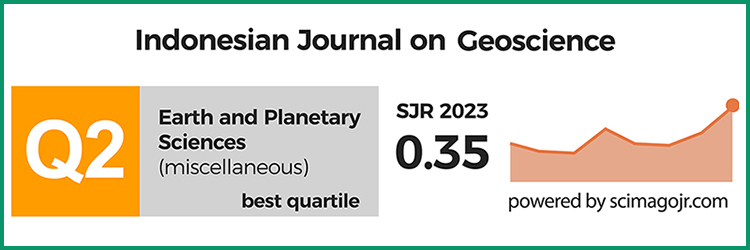Ore Characteristics and Fluid Inclusion of the Base Metal Vein Deposit in Moncong Bincanai Area, Gowa, South Sulawesi, Indonesia
DOI:
https://doi.org/10.17014/ijog.7.4.189-197Keywords:
epithermal vein, base metal, ore mineralization, fluid inclusionAbstract
This paper is dealing with ore characteristics and fluid inclusion of the Moncong Bincanai, Biringbulu Subregency of Gowa Regency, South Sulawesi Province, Indonesia. The mineralization is a vein type, with the orientation of N170oE /65oSW, hosted in open-space filling within basalt. The mineralization consists of galena, sphalerite, chalcopyrite, and pyrite. Vein thickness ranges from 5 - 17 cm, showing a crustiform banding texture, with a sequence from outer to centre: quartz, carbonate (siderite), sulphide. The quartz displays primary growth textures such as comb, crystalline, saccharoidal, and colloform. Analytical methods applied include AAS and fluid inclusion microthermometry. Chemical composition of the vein indicates an average of Pb = 47.92%, Cu = 1.27%, Zn = 1.02%, and Fe = 9.46%, which shows a significant concentration of Pb. Fluid inclusion microthermometry results indicate a range of formation temperature of 240 - 250C and salinity of the responsible hydrothermal fluid of 2.1 - 2.5 wt.% NaCl eq. The deposit is categorized into low-sulfidation epithermal deposits, which was formed within a range of 410 - 440 m below paleosurface.
References
Bodnar, R.J., 1993. Revised Equation and Table for Determining the Freezing Point Depression of Hp-NaCl Solutions. Geochimica et Cosmochimica Acta, 57, p.683-684. doi:10.1016/0016-7037(93)90378-A
Darman, H. and Sidi, F.H., 2000. An Outline of the Geology of Indonesia. Proceedings of Indonesian Association of Geologists (IAGI), Jakarta, 192pp.
Dinas Pertarnbangan dan Energi Kabupaten Gowa, 2007. Peta Geologi Lembar Sapaya Kabupaten Gowa Provinsi Sulawesi Selatan, Dinas Pertambangan dan Energi Kabupaten Gowa.
Evans, A.M., 1993. Ore Geology and Industrial Minerals, 3'd Edition, Blackwell Science Ltd., USA. doi:10.1002/gj.3350290310
Haas, J.L., 1971. The Effect of Salinity on the Maximum Thermal Gradient of a Hydrothermal System at Hydrostatic Pressme. Economic Geology, 66, p.940-946. doi:10.2113/gsecongeo.66.6.940
Hedenquist, J.W, Arribas, R.A., and Gonzalez-Urien, E., 2000. Exploration for Epithermal Gold Deposits. SEG Reviews, 13, p.245-277.
Morrison, G.W, Dong, G., and Jaireth, S., 1990. Textural Zoning in Epithermal Quartz Veins,Amira Project P247, Gold Research Group, James Cook University of North Queensland, 33pp.
Nur, I.,Idrus, A, Prarnmnijoyo, S., Harijoko, A, Sufriadin, Jaya, A.H.S., and Irfan, U.R., 2009. Geologi endapan urat logam dasar Pb daerah Batmappe Kabupaten Gowa, Sulawesi Selatan. Proceedings PIT JAGI.XXXIV, p.629-637.
Shepherd, T.J., Rankin, A H., and Alderton, D.H.M., 1985. A Practical Guide to Fluid Inclusion Studies. Blackie and Son Ltd., Glasgow, 239pp.
Sukarnto, R. and Supriatna, S., 1982. Geologic Map of the Ujung Pandang, Benteng and Sinjai Quadrangles, Sulawesi. Geological Research and Development Centre, Bandung.
Zulkifli, M.D., Tholib, A., Franklin, Sofyan A, and Sudiarnan, 2002. Inventarisasi dan Evaluasi Mineral Logam di Kabupaten Takalar dan Kabupaten Gowa Provinsi Sulawesi Selatan". Subdit. Mineral Logam Direktorat Inventarisasi Sumber Daya Mineral, Bandung.



















